Community Health Promotion: Needs of Aging Population in Wollongong
VerifiedAdded on 2023/01/20
|7
|1785
|32
Report
AI Summary
This report examines community health promotion strategies for the aging population of Wollongong, Australia. It begins with an introduction highlighting the increasing global prevalence of health issues related to healthy aging and the significance of providing adequate care for older adults. The report then details the community characteristics of Wollongong, noting factors such as social cohesion, demographics, and potential health determinants including nutritional status, access to healthcare, and crime rates. Primary data sources, such as field reports and experimental studies, are identified along with secondary sources like peer-reviewed journals and government surveys. The report analyzes two journal articles to understand the specific health needs of the aging population, including cognitive decline and domestic violence, and discusses the methodologies employed (interviews and surveys). The conclusion emphasizes the importance of addressing the specific needs of older adults and the use of various data sources to gain a comprehensive understanding of the issues. This report provides valuable insights into health promotion in an aging community.
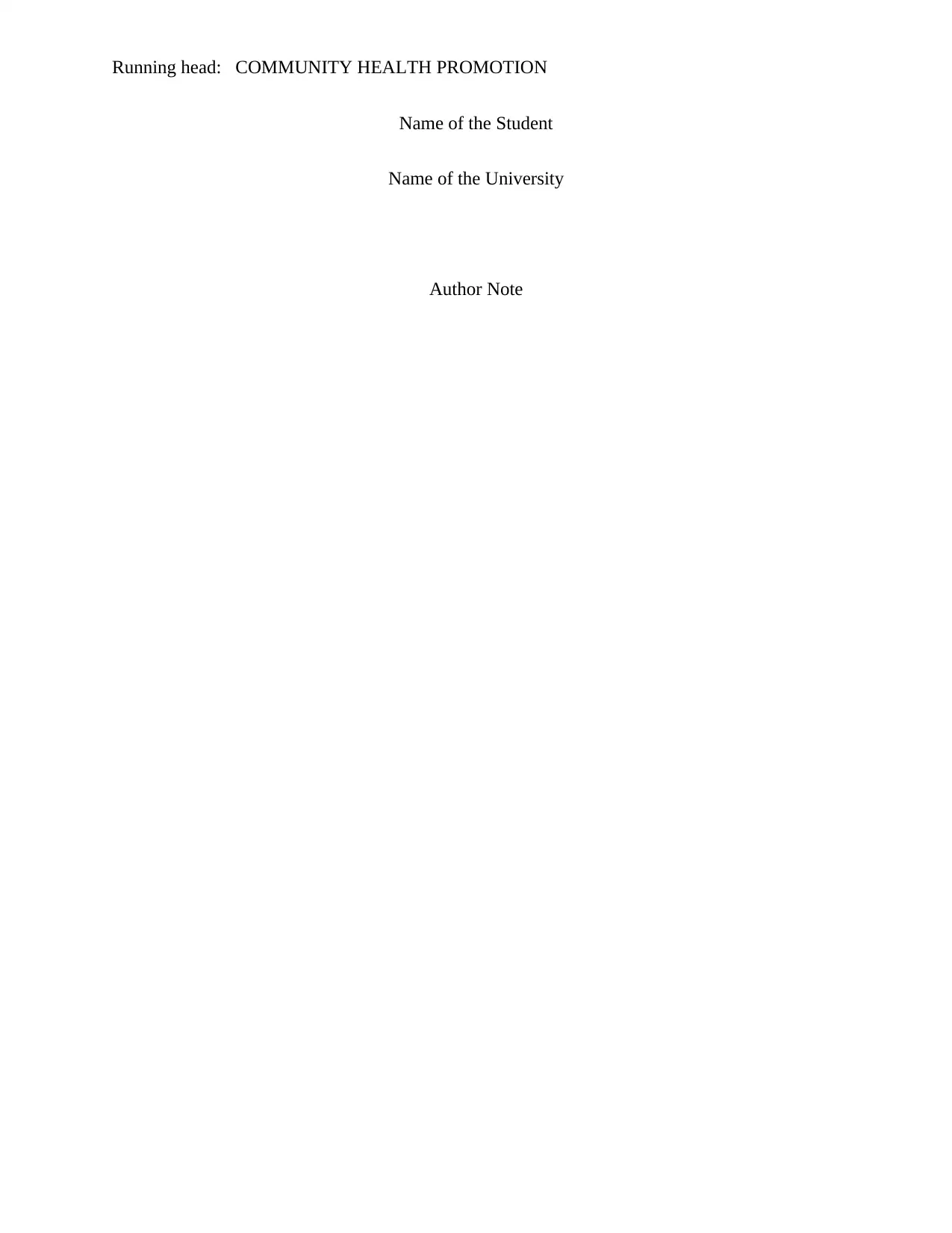
Running head: COMMUNITY HEALTH PROMOTION
Name of the Student
Name of the University
Author Note
Name of the Student
Name of the University
Author Note
Paraphrase This Document
Need a fresh take? Get an instant paraphrase of this document with our AI Paraphraser
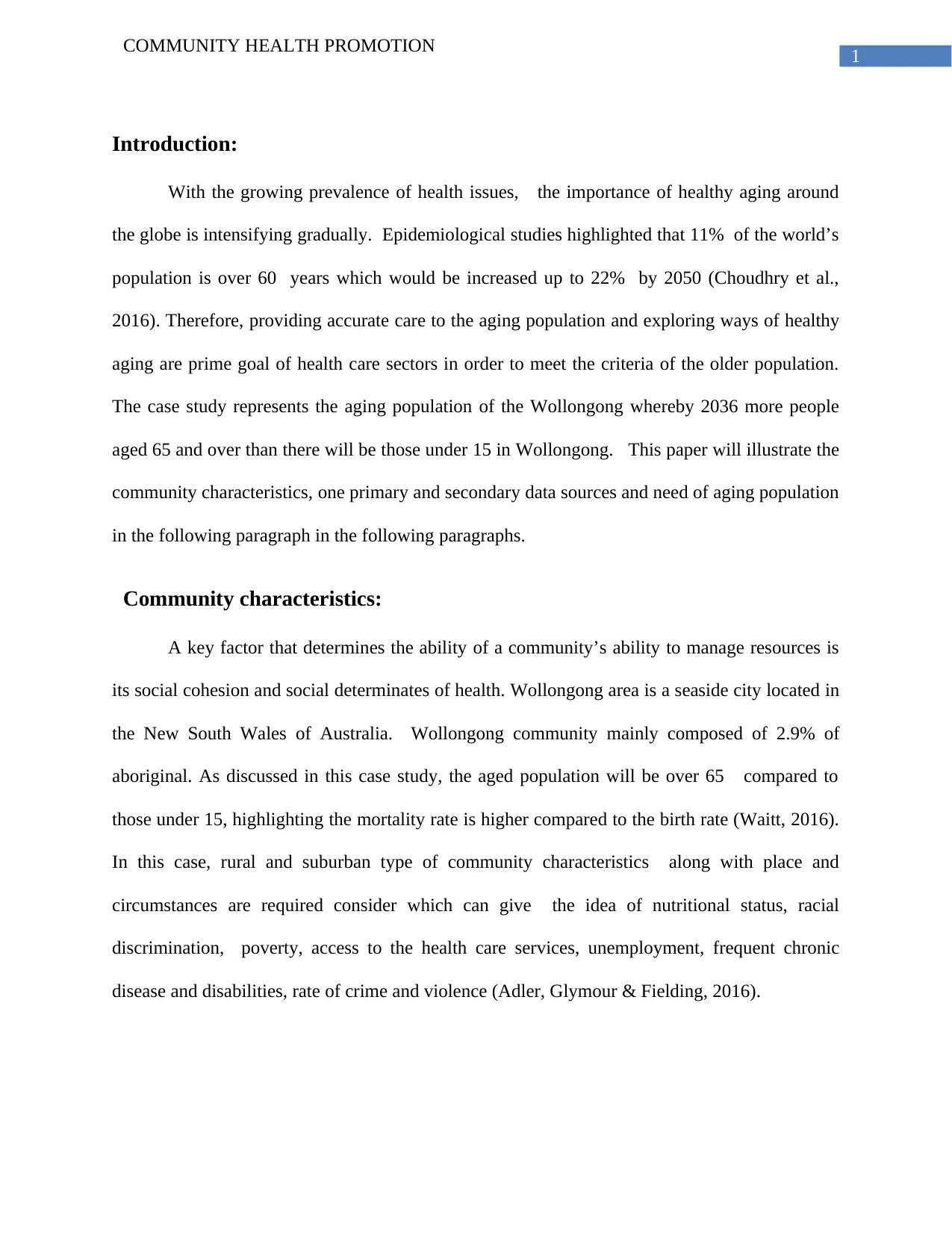
1
COMMUNITY HEALTH PROMOTION
Introduction:
With the growing prevalence of health issues, the importance of healthy aging around
the globe is intensifying gradually. Epidemiological studies highlighted that 11% of the world’s
population is over 60 years which would be increased up to 22% by 2050 (Choudhry et al.,
2016). Therefore, providing accurate care to the aging population and exploring ways of healthy
aging are prime goal of health care sectors in order to meet the criteria of the older population.
The case study represents the aging population of the Wollongong whereby 2036 more people
aged 65 and over than there will be those under 15 in Wollongong. This paper will illustrate the
community characteristics, one primary and secondary data sources and need of aging population
in the following paragraph in the following paragraphs.
Community characteristics:
A key factor that determines the ability of a community’s ability to manage resources is
its social cohesion and social determinates of health. Wollongong area is a seaside city located in
the New South Wales of Australia. Wollongong community mainly composed of 2.9% of
aboriginal. As discussed in this case study, the aged population will be over 65 compared to
those under 15, highlighting the mortality rate is higher compared to the birth rate (Waitt, 2016).
In this case, rural and suburban type of community characteristics along with place and
circumstances are required consider which can give the idea of nutritional status, racial
discrimination, poverty, access to the health care services, unemployment, frequent chronic
disease and disabilities, rate of crime and violence (Adler, Glymour & Fielding, 2016).
COMMUNITY HEALTH PROMOTION
Introduction:
With the growing prevalence of health issues, the importance of healthy aging around
the globe is intensifying gradually. Epidemiological studies highlighted that 11% of the world’s
population is over 60 years which would be increased up to 22% by 2050 (Choudhry et al.,
2016). Therefore, providing accurate care to the aging population and exploring ways of healthy
aging are prime goal of health care sectors in order to meet the criteria of the older population.
The case study represents the aging population of the Wollongong whereby 2036 more people
aged 65 and over than there will be those under 15 in Wollongong. This paper will illustrate the
community characteristics, one primary and secondary data sources and need of aging population
in the following paragraph in the following paragraphs.
Community characteristics:
A key factor that determines the ability of a community’s ability to manage resources is
its social cohesion and social determinates of health. Wollongong area is a seaside city located in
the New South Wales of Australia. Wollongong community mainly composed of 2.9% of
aboriginal. As discussed in this case study, the aged population will be over 65 compared to
those under 15, highlighting the mortality rate is higher compared to the birth rate (Waitt, 2016).
In this case, rural and suburban type of community characteristics along with place and
circumstances are required consider which can give the idea of nutritional status, racial
discrimination, poverty, access to the health care services, unemployment, frequent chronic
disease and disabilities, rate of crime and violence (Adler, Glymour & Fielding, 2016).
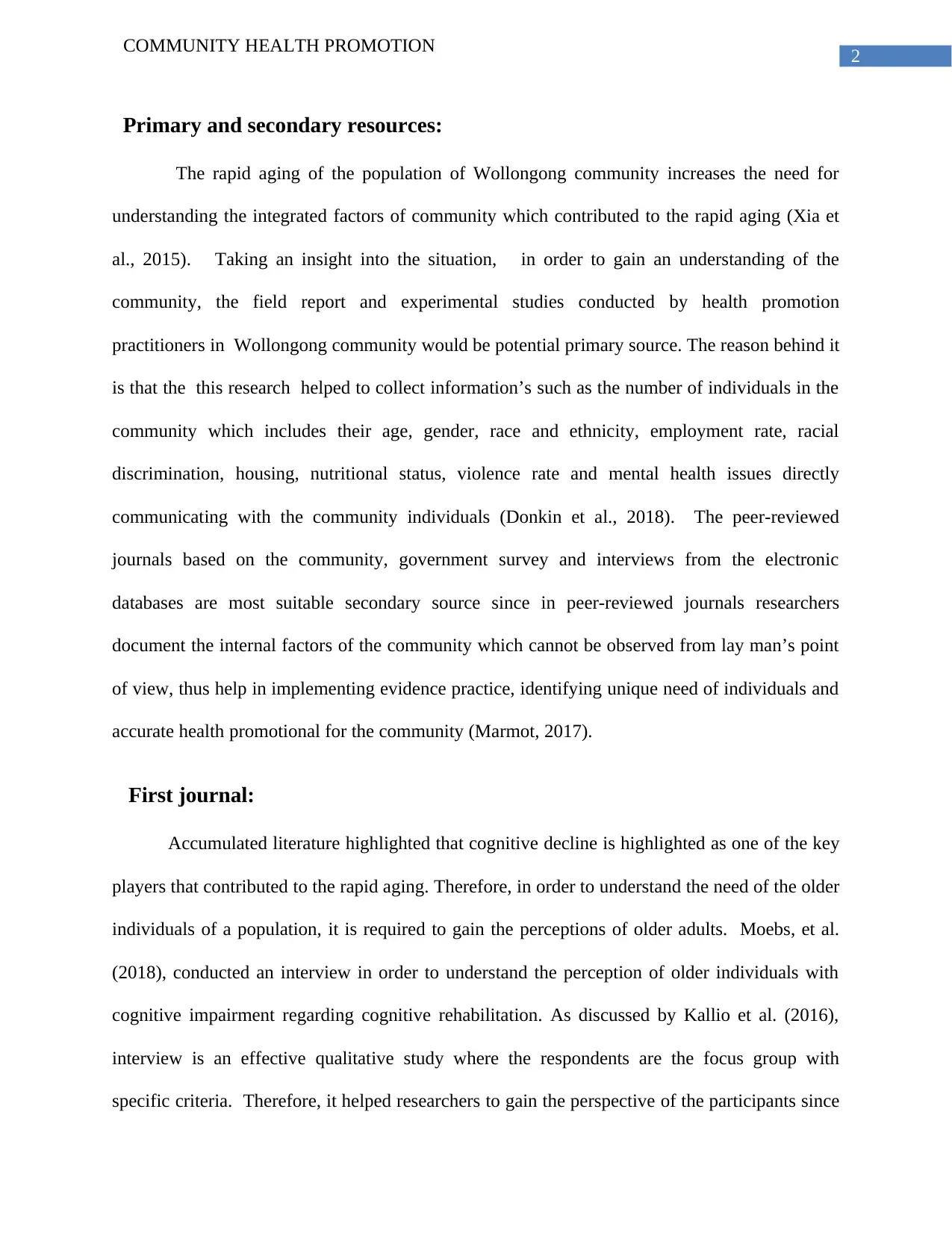
2
COMMUNITY HEALTH PROMOTION
Primary and secondary resources:
The rapid aging of the population of Wollongong community increases the need for
understanding the integrated factors of community which contributed to the rapid aging (Xia et
al., 2015). Taking an insight into the situation, in order to gain an understanding of the
community, the field report and experimental studies conducted by health promotion
practitioners in Wollongong community would be potential primary source. The reason behind it
is that the this research helped to collect information’s such as the number of individuals in the
community which includes their age, gender, race and ethnicity, employment rate, racial
discrimination, housing, nutritional status, violence rate and mental health issues directly
communicating with the community individuals (Donkin et al., 2018). The peer-reviewed
journals based on the community, government survey and interviews from the electronic
databases are most suitable secondary source since in peer-reviewed journals researchers
document the internal factors of the community which cannot be observed from lay man’s point
of view, thus help in implementing evidence practice, identifying unique need of individuals and
accurate health promotional for the community (Marmot, 2017).
First journal:
Accumulated literature highlighted that cognitive decline is highlighted as one of the key
players that contributed to the rapid aging. Therefore, in order to understand the need of the older
individuals of a population, it is required to gain the perceptions of older adults. Moebs, et al.
(2018), conducted an interview in order to understand the perception of older individuals with
cognitive impairment regarding cognitive rehabilitation. As discussed by Kallio et al. (2016),
interview is an effective qualitative study where the respondents are the focus group with
specific criteria. Therefore, it helped researchers to gain the perspective of the participants since
COMMUNITY HEALTH PROMOTION
Primary and secondary resources:
The rapid aging of the population of Wollongong community increases the need for
understanding the integrated factors of community which contributed to the rapid aging (Xia et
al., 2015). Taking an insight into the situation, in order to gain an understanding of the
community, the field report and experimental studies conducted by health promotion
practitioners in Wollongong community would be potential primary source. The reason behind it
is that the this research helped to collect information’s such as the number of individuals in the
community which includes their age, gender, race and ethnicity, employment rate, racial
discrimination, housing, nutritional status, violence rate and mental health issues directly
communicating with the community individuals (Donkin et al., 2018). The peer-reviewed
journals based on the community, government survey and interviews from the electronic
databases are most suitable secondary source since in peer-reviewed journals researchers
document the internal factors of the community which cannot be observed from lay man’s point
of view, thus help in implementing evidence practice, identifying unique need of individuals and
accurate health promotional for the community (Marmot, 2017).
First journal:
Accumulated literature highlighted that cognitive decline is highlighted as one of the key
players that contributed to the rapid aging. Therefore, in order to understand the need of the older
individuals of a population, it is required to gain the perceptions of older adults. Moebs, et al.
(2018), conducted an interview in order to understand the perception of older individuals with
cognitive impairment regarding cognitive rehabilitation. As discussed by Kallio et al. (2016),
interview is an effective qualitative study where the respondents are the focus group with
specific criteria. Therefore, it helped researchers to gain the perspective of the participants since
⊘ This is a preview!⊘
Do you want full access?
Subscribe today to unlock all pages.

Trusted by 1+ million students worldwide
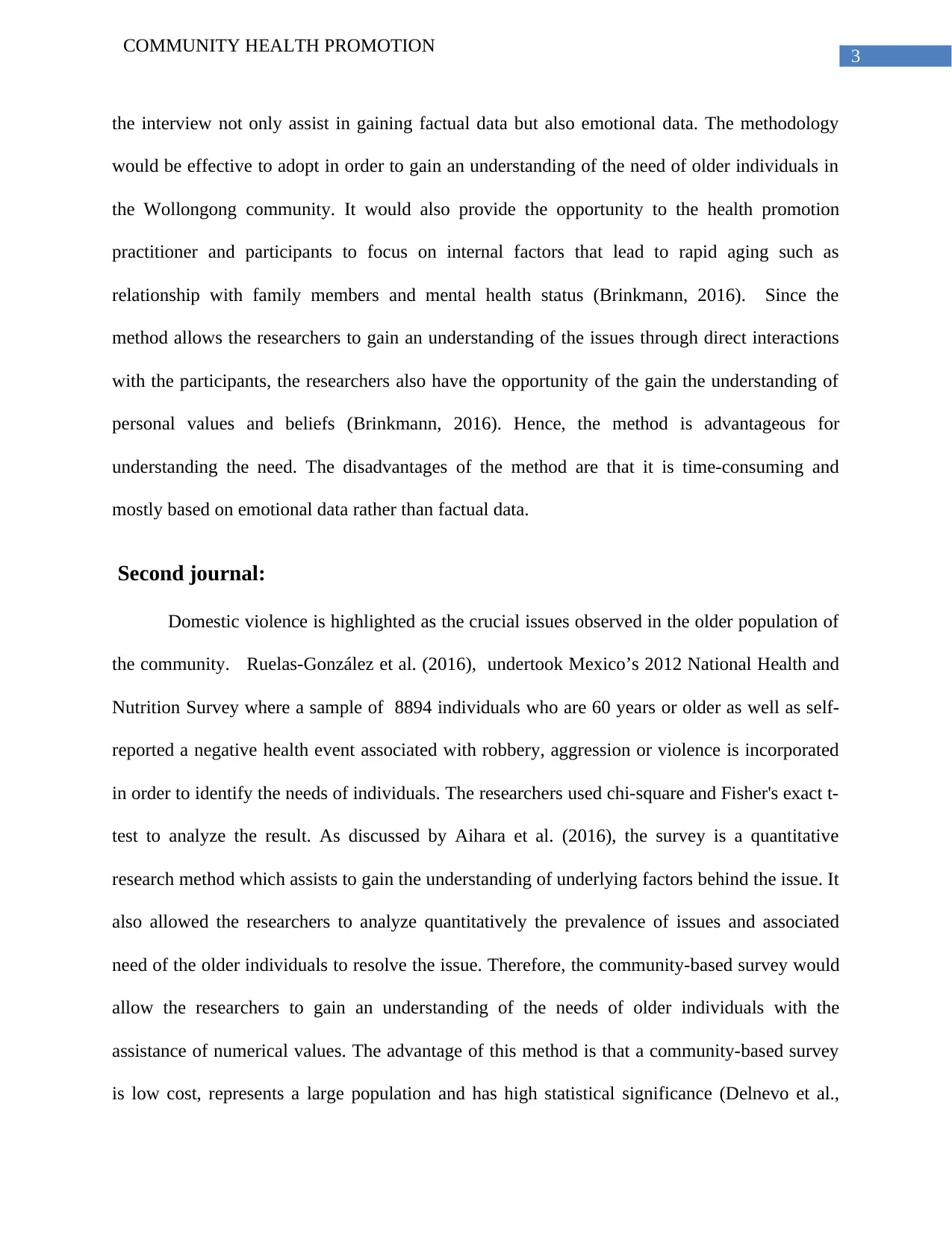
3
COMMUNITY HEALTH PROMOTION
the interview not only assist in gaining factual data but also emotional data. The methodology
would be effective to adopt in order to gain an understanding of the need of older individuals in
the Wollongong community. It would also provide the opportunity to the health promotion
practitioner and participants to focus on internal factors that lead to rapid aging such as
relationship with family members and mental health status (Brinkmann, 2016). Since the
method allows the researchers to gain an understanding of the issues through direct interactions
with the participants, the researchers also have the opportunity of the gain the understanding of
personal values and beliefs (Brinkmann, 2016). Hence, the method is advantageous for
understanding the need. The disadvantages of the method are that it is time-consuming and
mostly based on emotional data rather than factual data.
Second journal:
Domestic violence is highlighted as the crucial issues observed in the older population of
the community. Ruelas-González et al. (2016), undertook Mexico’s 2012 National Health and
Nutrition Survey where a sample of 8894 individuals who are 60 years or older as well as self-
reported a negative health event associated with robbery, aggression or violence is incorporated
in order to identify the needs of individuals. The researchers used chi-square and Fisher's exact t-
test to analyze the result. As discussed by Aihara et al. (2016), the survey is a quantitative
research method which assists to gain the understanding of underlying factors behind the issue. It
also allowed the researchers to analyze quantitatively the prevalence of issues and associated
need of the older individuals to resolve the issue. Therefore, the community-based survey would
allow the researchers to gain an understanding of the needs of older individuals with the
assistance of numerical values. The advantage of this method is that a community-based survey
is low cost, represents a large population and has high statistical significance (Delnevo et al.,
COMMUNITY HEALTH PROMOTION
the interview not only assist in gaining factual data but also emotional data. The methodology
would be effective to adopt in order to gain an understanding of the need of older individuals in
the Wollongong community. It would also provide the opportunity to the health promotion
practitioner and participants to focus on internal factors that lead to rapid aging such as
relationship with family members and mental health status (Brinkmann, 2016). Since the
method allows the researchers to gain an understanding of the issues through direct interactions
with the participants, the researchers also have the opportunity of the gain the understanding of
personal values and beliefs (Brinkmann, 2016). Hence, the method is advantageous for
understanding the need. The disadvantages of the method are that it is time-consuming and
mostly based on emotional data rather than factual data.
Second journal:
Domestic violence is highlighted as the crucial issues observed in the older population of
the community. Ruelas-González et al. (2016), undertook Mexico’s 2012 National Health and
Nutrition Survey where a sample of 8894 individuals who are 60 years or older as well as self-
reported a negative health event associated with robbery, aggression or violence is incorporated
in order to identify the needs of individuals. The researchers used chi-square and Fisher's exact t-
test to analyze the result. As discussed by Aihara et al. (2016), the survey is a quantitative
research method which assists to gain the understanding of underlying factors behind the issue. It
also allowed the researchers to analyze quantitatively the prevalence of issues and associated
need of the older individuals to resolve the issue. Therefore, the community-based survey would
allow the researchers to gain an understanding of the needs of older individuals with the
assistance of numerical values. The advantage of this method is that a community-based survey
is low cost, represents a large population and has high statistical significance (Delnevo et al.,
Paraphrase This Document
Need a fresh take? Get an instant paraphrase of this document with our AI Paraphraser
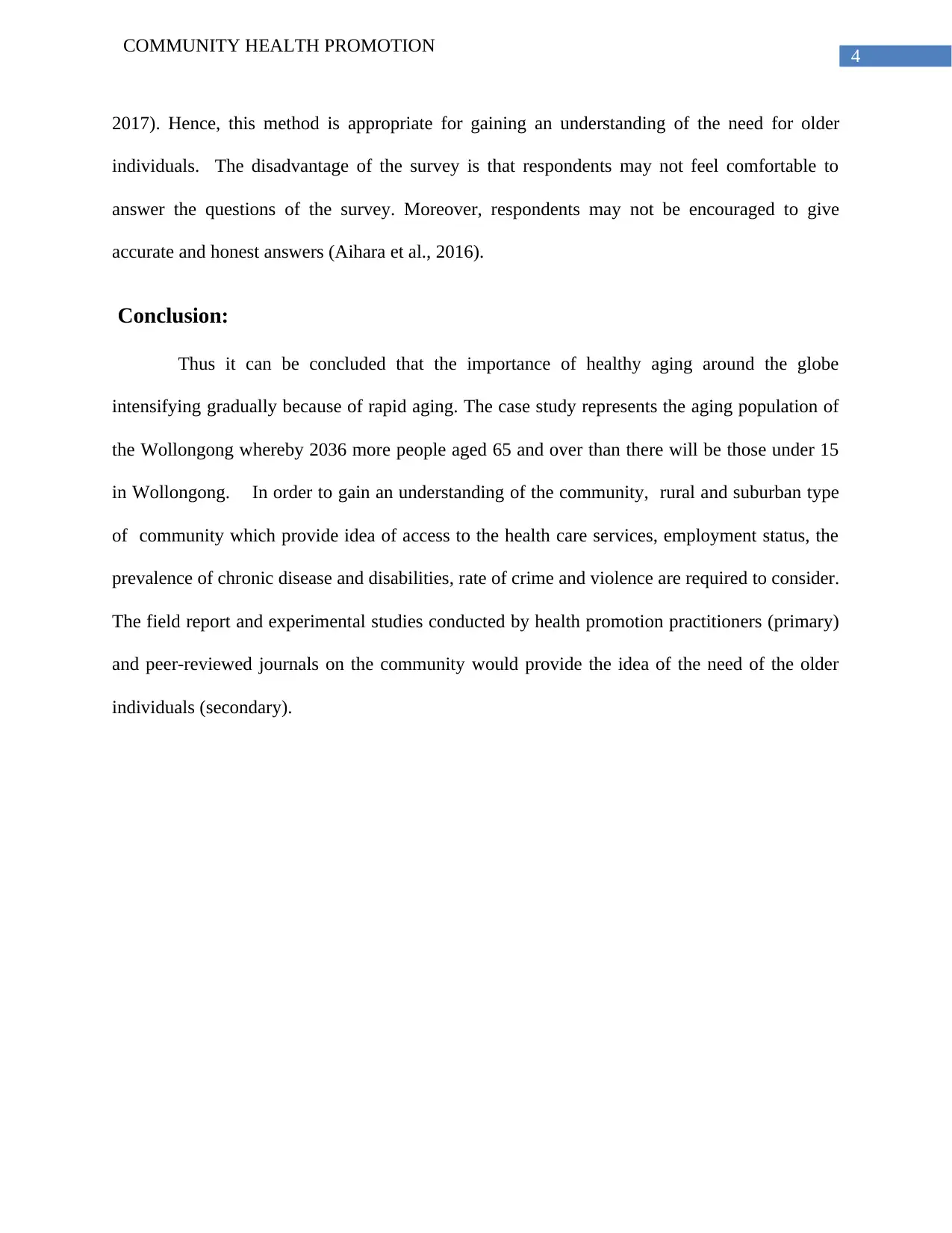
4
COMMUNITY HEALTH PROMOTION
2017). Hence, this method is appropriate for gaining an understanding of the need for older
individuals. The disadvantage of the survey is that respondents may not feel comfortable to
answer the questions of the survey. Moreover, respondents may not be encouraged to give
accurate and honest answers (Aihara et al., 2016).
Conclusion:
Thus it can be concluded that the importance of healthy aging around the globe
intensifying gradually because of rapid aging. The case study represents the aging population of
the Wollongong whereby 2036 more people aged 65 and over than there will be those under 15
in Wollongong. In order to gain an understanding of the community, rural and suburban type
of community which provide idea of access to the health care services, employment status, the
prevalence of chronic disease and disabilities, rate of crime and violence are required to consider.
The field report and experimental studies conducted by health promotion practitioners (primary)
and peer-reviewed journals on the community would provide the idea of the need of the older
individuals (secondary).
COMMUNITY HEALTH PROMOTION
2017). Hence, this method is appropriate for gaining an understanding of the need for older
individuals. The disadvantage of the survey is that respondents may not feel comfortable to
answer the questions of the survey. Moreover, respondents may not be encouraged to give
accurate and honest answers (Aihara et al., 2016).
Conclusion:
Thus it can be concluded that the importance of healthy aging around the globe
intensifying gradually because of rapid aging. The case study represents the aging population of
the Wollongong whereby 2036 more people aged 65 and over than there will be those under 15
in Wollongong. In order to gain an understanding of the community, rural and suburban type
of community which provide idea of access to the health care services, employment status, the
prevalence of chronic disease and disabilities, rate of crime and violence are required to consider.
The field report and experimental studies conducted by health promotion practitioners (primary)
and peer-reviewed journals on the community would provide the idea of the need of the older
individuals (secondary).
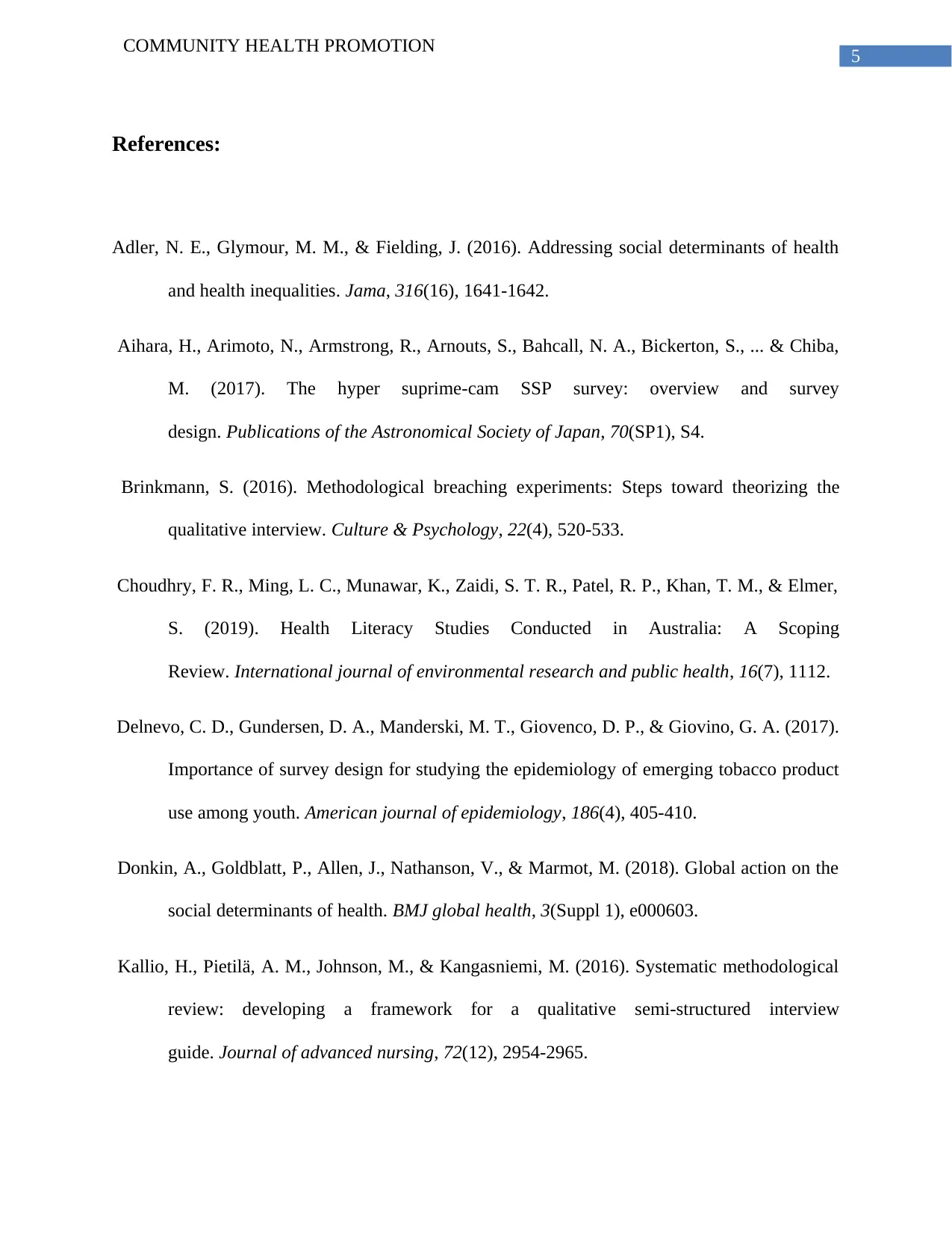
5
COMMUNITY HEALTH PROMOTION
References:
Adler, N. E., Glymour, M. M., & Fielding, J. (2016). Addressing social determinants of health
and health inequalities. Jama, 316(16), 1641-1642.
Aihara, H., Arimoto, N., Armstrong, R., Arnouts, S., Bahcall, N. A., Bickerton, S., ... & Chiba,
M. (2017). The hyper suprime-cam SSP survey: overview and survey
design. Publications of the Astronomical Society of Japan, 70(SP1), S4.
Brinkmann, S. (2016). Methodological breaching experiments: Steps toward theorizing the
qualitative interview. Culture & Psychology, 22(4), 520-533.
Choudhry, F. R., Ming, L. C., Munawar, K., Zaidi, S. T. R., Patel, R. P., Khan, T. M., & Elmer,
S. (2019). Health Literacy Studies Conducted in Australia: A Scoping
Review. International journal of environmental research and public health, 16(7), 1112.
Delnevo, C. D., Gundersen, D. A., Manderski, M. T., Giovenco, D. P., & Giovino, G. A. (2017).
Importance of survey design for studying the epidemiology of emerging tobacco product
use among youth. American journal of epidemiology, 186(4), 405-410.
Donkin, A., Goldblatt, P., Allen, J., Nathanson, V., & Marmot, M. (2018). Global action on the
social determinants of health. BMJ global health, 3(Suppl 1), e000603.
Kallio, H., Pietilä, A. M., Johnson, M., & Kangasniemi, M. (2016). Systematic methodological
review: developing a framework for a qualitative semi‐structured interview
guide. Journal of advanced nursing, 72(12), 2954-2965.
COMMUNITY HEALTH PROMOTION
References:
Adler, N. E., Glymour, M. M., & Fielding, J. (2016). Addressing social determinants of health
and health inequalities. Jama, 316(16), 1641-1642.
Aihara, H., Arimoto, N., Armstrong, R., Arnouts, S., Bahcall, N. A., Bickerton, S., ... & Chiba,
M. (2017). The hyper suprime-cam SSP survey: overview and survey
design. Publications of the Astronomical Society of Japan, 70(SP1), S4.
Brinkmann, S. (2016). Methodological breaching experiments: Steps toward theorizing the
qualitative interview. Culture & Psychology, 22(4), 520-533.
Choudhry, F. R., Ming, L. C., Munawar, K., Zaidi, S. T. R., Patel, R. P., Khan, T. M., & Elmer,
S. (2019). Health Literacy Studies Conducted in Australia: A Scoping
Review. International journal of environmental research and public health, 16(7), 1112.
Delnevo, C. D., Gundersen, D. A., Manderski, M. T., Giovenco, D. P., & Giovino, G. A. (2017).
Importance of survey design for studying the epidemiology of emerging tobacco product
use among youth. American journal of epidemiology, 186(4), 405-410.
Donkin, A., Goldblatt, P., Allen, J., Nathanson, V., & Marmot, M. (2018). Global action on the
social determinants of health. BMJ global health, 3(Suppl 1), e000603.
Kallio, H., Pietilä, A. M., Johnson, M., & Kangasniemi, M. (2016). Systematic methodological
review: developing a framework for a qualitative semi‐structured interview
guide. Journal of advanced nursing, 72(12), 2954-2965.
⊘ This is a preview!⊘
Do you want full access?
Subscribe today to unlock all pages.

Trusted by 1+ million students worldwide
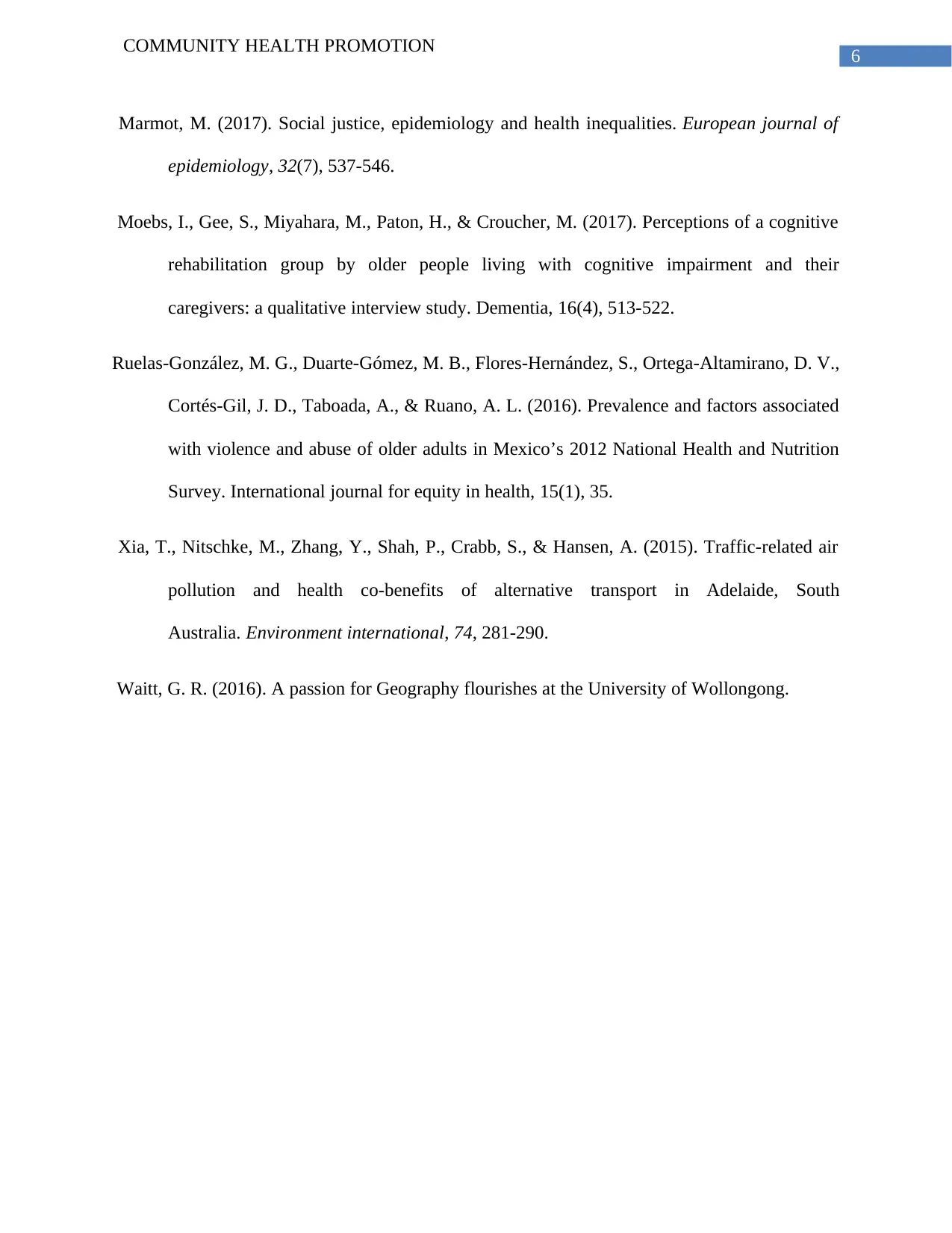
6
COMMUNITY HEALTH PROMOTION
Marmot, M. (2017). Social justice, epidemiology and health inequalities. European journal of
epidemiology, 32(7), 537-546.
Moebs, I., Gee, S., Miyahara, M., Paton, H., & Croucher, M. (2017). Perceptions of a cognitive
rehabilitation group by older people living with cognitive impairment and their
caregivers: a qualitative interview study. Dementia, 16(4), 513-522.
Ruelas-González, M. G., Duarte-Gómez, M. B., Flores-Hernández, S., Ortega-Altamirano, D. V.,
Cortés-Gil, J. D., Taboada, A., & Ruano, A. L. (2016). Prevalence and factors associated
with violence and abuse of older adults in Mexico’s 2012 National Health and Nutrition
Survey. International journal for equity in health, 15(1), 35.
Xia, T., Nitschke, M., Zhang, Y., Shah, P., Crabb, S., & Hansen, A. (2015). Traffic-related air
pollution and health co-benefits of alternative transport in Adelaide, South
Australia. Environment international, 74, 281-290.
Waitt, G. R. (2016). A passion for Geography flourishes at the University of Wollongong.
COMMUNITY HEALTH PROMOTION
Marmot, M. (2017). Social justice, epidemiology and health inequalities. European journal of
epidemiology, 32(7), 537-546.
Moebs, I., Gee, S., Miyahara, M., Paton, H., & Croucher, M. (2017). Perceptions of a cognitive
rehabilitation group by older people living with cognitive impairment and their
caregivers: a qualitative interview study. Dementia, 16(4), 513-522.
Ruelas-González, M. G., Duarte-Gómez, M. B., Flores-Hernández, S., Ortega-Altamirano, D. V.,
Cortés-Gil, J. D., Taboada, A., & Ruano, A. L. (2016). Prevalence and factors associated
with violence and abuse of older adults in Mexico’s 2012 National Health and Nutrition
Survey. International journal for equity in health, 15(1), 35.
Xia, T., Nitschke, M., Zhang, Y., Shah, P., Crabb, S., & Hansen, A. (2015). Traffic-related air
pollution and health co-benefits of alternative transport in Adelaide, South
Australia. Environment international, 74, 281-290.
Waitt, G. R. (2016). A passion for Geography flourishes at the University of Wollongong.
1 out of 7
Related Documents
Your All-in-One AI-Powered Toolkit for Academic Success.
+13062052269
info@desklib.com
Available 24*7 on WhatsApp / Email
![[object Object]](/_next/static/media/star-bottom.7253800d.svg)
Unlock your academic potential
Copyright © 2020–2025 A2Z Services. All Rights Reserved. Developed and managed by ZUCOL.





